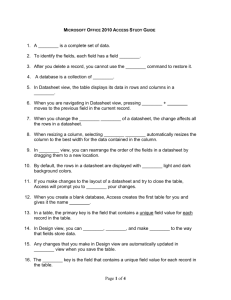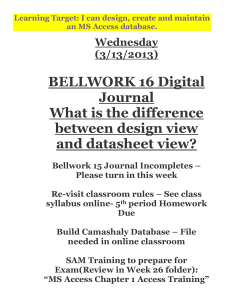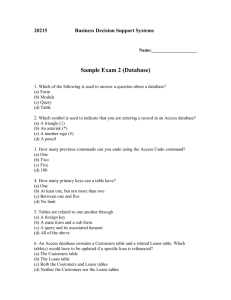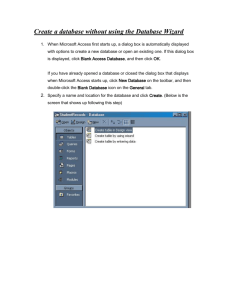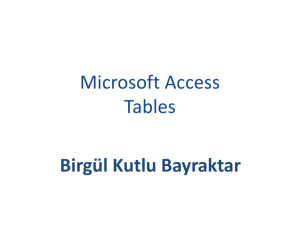Database Review Questions and Answers
advertisement
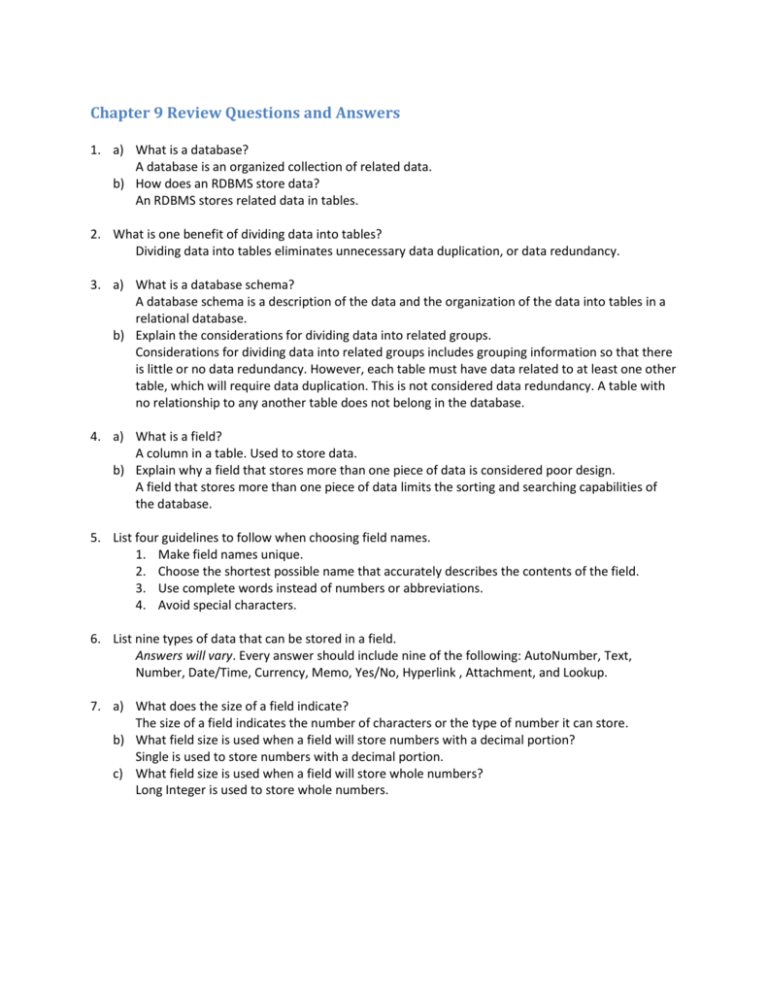
Chapter 9 Review Questions and Answers 1. a) What is a database? A database is an organized collection of related data. b) How does an RDBMS store data? An RDBMS stores related data in tables. 2. What is one benefit of dividing data into tables? Dividing data into tables eliminates unnecessary data duplication, or data redundancy. 3. a) What is a database schema? A database schema is a description of the data and the organization of the data into tables in a relational database. b) Explain the considerations for dividing data into related groups. Considerations for dividing data into related groups includes grouping information so that there is little or no data redundancy. However, each table must have data related to at least one other table, which will require data duplication. This is not considered data redundancy. A table with no relationship to any another table does not belong in the database. 4. a) What is a field? A column in a table. Used to store data. b) Explain why a field that stores more than one piece of data is considered poor design. A field that stores more than one piece of data limits the sorting and searching capabilities of the database. 5. List four guidelines to follow when choosing field names. 1. Make field names unique. 2. Choose the shortest possible name that accurately describes the contents of the field. 3. Use complete words instead of numbers or abbreviations. 4. Avoid special characters. 6. List nine types of data that can be stored in a field. Answers will vary. Every answer should include nine of the following: AutoNumber, Text, Number, Date/Time, Currency, Memo, Yes/No, Hyperlink , Attachment, and Lookup. 7. a) What does the size of a field indicate? The size of a field indicates the number of characters or the type of number it can store. b) What field size is used when a field will store numbers with a decimal portion? Single is used to store numbers with a decimal portion. c) What field size is used when a field will store whole numbers? Long Integer is used to store whole numbers. 8. a) What does the format of a field determine? The format of a field determines how the data is displayed. b) List four numeric field formats. General Number Fixed Percent Standard c) List three date/time field formats. Long Medium Short d) Do text fields have a field format? Text fields do not have a field format. 9. For each of the field names below, list the most appropriate data type (Text, Number, Date/Time, Currency, Memo, Yes/No, Hyperlink, and AutoNumber) Use each type only once: a) Retail Price Currency b) Order Date Date/Time c) First Name Text d) Product Description Memo e) E-Mail Address Hyperlink f) Record ID AutoNumber g) Delivery Time Date/Time h) Peanut Allergy Yes/No i) Quantity Number 10. a) What is a record? A record is a set of data for the fields in a table. b) Can a table contain duplicate records? Explain. No, because a table has a field that is designated the primary key. The primary key field must contain unique values. c) What is used in a table to ensure that records are unique? To ensure that no two records in a table are the same, one field in each table must be designated the primary key. 11. a) What must be done to designate a primary key? Click anywhere in the primary key field and then click Design > Primary key. b) What is the Required option used for? The Required option is used to ensure that each record has a primary key entry. c) List the steps required to make two fields the primary key of a table. 1. Click the gray box to the left of the first field. 2. Hold down the Ctrl key and then click the gray box to the left of the second field. 3. Click Design > Primary Key. 12. a) What is a form? A form is a database object used for entering records into a table and for viewing existing records. b) List three kinds of forms. Three kinds of forms include simple, split, and multiple items forms. 13. a) Why would a logo be added to a form? A logo would be added to a form to give it a professional appearance and indicate it is an official company form. b) List three types of formatting that can be applied to a form. Three types of formatting that can be applied to a form are bold, font size, and predefined formats. 14. Which view must a form be in to add records? A form must be in Form view to add records. 15. a) Where are the record controls located? The record controls are located at the bottom of a form. b) What are the record controls used for? Record controls are used to display a specific record in a form or for displaying a new, empty record. 16. How does a form make entering records less error-prone? A form can make data entry less error-prone because only one record at a time is displayed. 17. a) What is Datasheet view? Datasheet view displays a table in a datasheet where fields are in columns and records in rows. b) List two reasons for using Datasheet view. Datasheet view is useful for comparing records and if often used when sorting and filtering data. c) List one way to change a column’s width. Answers will vary. Double-click the right column boundary. d) List the steps required to change the order of fields. 1. Point to the bottom border of the field name. 2. Drag the field to the new position. e) List two formats and tell why they can improve the readability of a datasheet. Alternate Fill/Back Color shades every other row making the data easier to read. Bold can be used to make text appear heavier. 18. List the similarities between a datasheet and a worksheet. Answers will vary. A datasheet and a worksheet are both organized into rows and columns, both can be sorted and filtered, and both can have formatting applied making the data easier to read. 19. a) What is sorting? Sorting means to place records in a specified order. b) Explain the difference between ascending and descending order. Ascending order places records from lowest to highest and descending order places records from highest to lowest. 20. a) What is filtering? Displaying records based on specified criteria. b) Explain how a filter is different from a sort. A filter displays only certain records that meet a specified criteria, whereas sorting places records in a specified order. 21. a) Why preview a datasheet before printing? To see what the printouts will look like. b) How can more columns be printed on a sheet of paper? More columns can be printed by changing the page orientation to Landscape or by setting the margins to Narrow. c) What are two ways to print only certain records? Select the records before printing or by applying a filter. 22. a) Which view is a table modified from? A table is modified from Design view. b) When a field name is changed, what must be done to update the corresponding form? Nothing. A form automatically updates to reflect new field names. 23. a) List the steps for changing an entry in an existing record. 1. Click the record controls until the appropriate record is selected. 2. Double-click the entry to be changed. 3. Type to replace the existing data. b) Can an existing record be deleted? Explain. Yes. An existing record can be deleted by clicking Home > Delete > Delete Record. 24. Can database data be copied to a worksheet? Explain. Yes database data can be copied to a worksheet by clicking Home > Copy, displaying the Excel worksheet, and then clicking Home > Paste. 25. a) What does “importing data” mean? A file from one application is converted for use by the receiving application. b) Name two file types supported by Access for importing data. Two supported file types are Excel files and Text files. 26. Explain how e-mail can be used to collect data. With this approach, an e-mail message includes a data entry form for the recipient to fill out and return. Responses can be either collected for processing later or automatically processed. When responses are automatically processed, records are added to the database as the e-mails are received. 27. List four ways to populate a database. 1. Type entries. 2. Use copy and paste to transfer data. 3. Import data. 4. Collect data through e-mail. 28. a) Each table in a database is related to another table by one field. True. b) All data in a table must be the same type. False. Data in a table can be a variety of types. c) Lookup fields allow for any type of data. False. Lookup fields allow only specified data that has been retrieved from a field in another table. d) A hyperlink field allows only e-mail entries. False. Hyperlink fields store links to files, e-mail addresses, and Web site addresses. e) Entering 3 in a field formatted as percent displays 30% in the entry box. False. Entering 3 in a field formatted as percent displays 300% in the entry box. f) The primary key in a database is used to prevent duplicate records in a table. True. g) A Last Name field is a good candidate for a primary key field. False. This is a field where entries may not be unique. h) It is not possible to have a multiple-field primary key. False. It is possible to have a multiple-field primary key. i) A form cannot include an graphic. False. A graphic can be added to a form. j) A form cannot include a datasheet. False. A simple form displays a datasheet. k) Adding records is called multiplying the database. False. Adding records is called appending the database. l) Datasheet view displays one record at a time. False. Datasheet view displays a table. m) Records can be sorted in chronological order. True. n) Filtering removes records from a database. False. Filtered records are just hidden from view. o) Changing the print orientation of a datasheet may allow more columns to fit on a sheet of paper. True. p) A form is automatically updated when changes are made to the corresponding table. False. The original form needs to be deleted and a new form created. q) It is not possible to copy text from a Word document and paste it as an entry in a database form. False. It is possible to copy text from a Word document and paste it as an entry in a database form. r) Appended data overwrites existing records in a table. False. Appended data is added to the end of a table. s) E-mail cannot be used to collect data. False. Data can be collected with E-mail.
